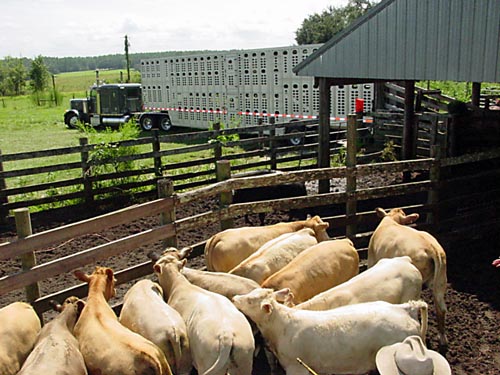Want a Five to One Return on Investment?
Use Growth Implants on Your Calves
 Over 50 years of data indicate that one of the management practices that improves performance and productivity the most in beef cattle is growth implants in nursing calves. Use of these highly tested and approved products increase both feed efficiency and average daily gain. Growth implanting calves rarely returns less than $5 for every $1 spent and frequently returns $10 for every $1 of product cost. Despite this evidence, some surveys indicate only about 30% of beef producers utilize this management practice. If your calves are enrolled in a marketing program that prevents implants, hopefully you are being compensated enough to make up for the loss of productivity and it is understandable not to utilize the practice. If your marketing program does not preclude this use of these products, you can receive considerable economic gain by implanting.
Over 50 years of data indicate that one of the management practices that improves performance and productivity the most in beef cattle is growth implants in nursing calves. Use of these highly tested and approved products increase both feed efficiency and average daily gain. Growth implanting calves rarely returns less than $5 for every $1 spent and frequently returns $10 for every $1 of product cost. Despite this evidence, some surveys indicate only about 30% of beef producers utilize this management practice. If your calves are enrolled in a marketing program that prevents implants, hopefully you are being compensated enough to make up for the loss of productivity and it is understandable not to utilize the practice. If your marketing program does not preclude this use of these products, you can receive considerable economic gain by implanting.
There is confusion and misunderstanding about the safety of growth implants by some of the consuming public. The products are tested, approved and regulated by the Food and Drug Administration (FDA). FDA regulations only allow the products to be administered through time-release implants placed under the skin of the animals’ ear. Each implant contains a specific, legally authorized dose of hormones. The implant ensures that the hormone is released into the animals’ bloodstream very slowly so that the concentration of the hormone in the animal remains relatively low and the ear does not enter the food chain.
Research indicates that use of supplemental hormones from implants in cattle has only a small impact on hormone levels in beef, well below the natural hormone levels in beef or the amounts produced naturally in our own bodies. According to the US Department of Agriculture (USDA), a person would need to eat over 10 pounds of beef from an implanted steer to equal the amount of estradiol naturally found in a single egg. One glass of milk contains about nine times as much estradiol as a half-pound of beef from an implanted steer. Plant based food products also contain hormonally active chemicals. A half-pound potato has 245 nanograms (ng) of estrogen equivalent, compared with 1.3 ng for a quarter pound of untreated beef and 1.9 ng for beef from an implanted steer. All of these levels are safe for consumption.
 Growth implants are another management tool that can be useful for beef producers to increase income and use less feed per pound of gain. This practice helps us more efficiently use our resources to continue to provide a safe, reasonably priced and nutritious product for consumers. For more information, visit this website and contact your local UF-IFAS Extension Office http://edis.ifas.ufl.edu/an318.
Growth implants are another management tool that can be useful for beef producers to increase income and use less feed per pound of gain. This practice helps us more efficiently use our resources to continue to provide a safe, reasonably priced and nutritious product for consumers. For more information, visit this website and contact your local UF-IFAS Extension Office http://edis.ifas.ufl.edu/an318.
If you have any pasture or livestock questions relating to Levy County please feel free to contact Ed Jennings, UF/IFAS Extension Director for Levy County at (352) 486-5131 or by email at edjennin@ufl.edu.
 0
0
